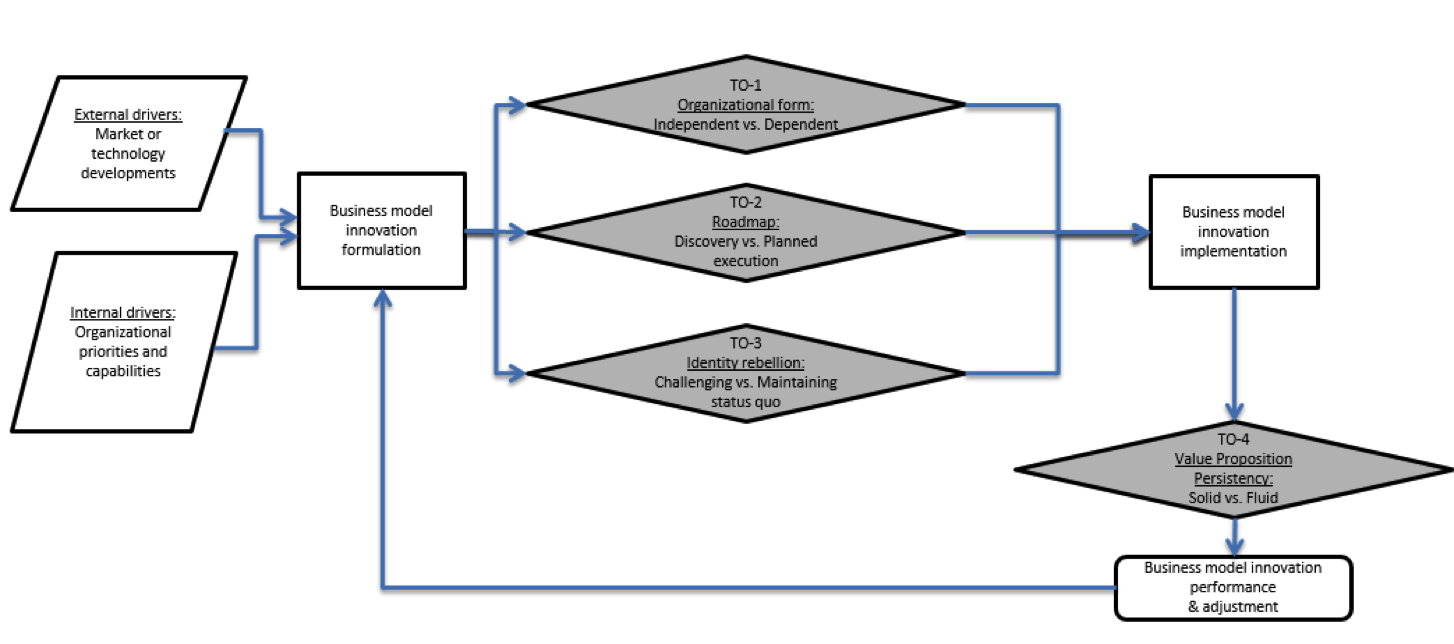The challenges of Business Model Innovation

What do ING and Marlies Dekkers have in common? Not much, at first sight. After all, ING, a Dutch bank, and Marlies Dekkers, a Dutch fashion house, operate in very different industries and apply completely different strategies. Through the lens of business model innovation, however, these two firms may have more in common than initially expected. Both firms launched business models that were new to their industries, and both faced similar challenges to implement them.
In our study, which appears in the next issue of Business Horizons, we analyzed the challenges that five business model innovators faced when implementing their new business models. We reveal four strategic trade-offs that business model innovators encounter, regarding organizational form, roadmapping, identity rebellion, and value proposition persistency.
Four implementation challenges
Disruptive technologies, changing consumer preferences and shifting competitive landscapes generate a continuous pressure on firm’s business models. Recent examples of innovative business models are Airbnb, Uber, WeChat, Netflix, LinkedIn and Alibaba. Developing novel ways on how to create and capture value – the definition of a business model - is a top priority for most business executives. Despite their efforts, business model innovation is notoriously difficult. Only 6% of executives are satisfied with their business model performance. So what are the challenges innovators face and how they try to tackle them?

Autonomy vs. integration
The first challenge relates to the organizational form in which the new business model will be implemented. A critical trade-off in this context is how much independence and autonomy is granted to the responsible business unit. As a director of Fortis Venturing described: “although our business unit is distinctive…we should also not estrange ourselves from the rest of the organization”. Business model innovators in our study tackled positioned them on the dependence-independence continuum by assessing the degree of unpredictability and disruptiveness of the innovation. When the business model innovation is highly disruptive, independence provides the innovator with the freedom to explore and develop the new model, and avoid cannibalization issues.
Roadmap planning vs. trial-and-error approach
The second challenge is about the degree to which the innovator should pursue roadmap planning in advance or start testing the new business model as soon as possible. This challenge taps into popular management concepts such as ‘lean’ and ‘agile’. Overall, we find that business model innovators should use to a trial-and-error approach because of the difficult to predict patterns of new business models, but at times planning may help when markets are somewhat predictable and stable. ING Direct could plan and assess the attractiveness of markets via market research, and thereby attain important market lead time advantages. Hotels.nl used a trial-and-error approach to quickly adapt its value proposition through experimenting in the online environment.
Rebellious vs. status quo
Choosing between a rebellious position – like Uber and Airbnb do - or adhering to the status quo is the third challenge. Hotels.nl took an aggressive stance to obtain market share and to differentiate itself from rivals, using sheep wearing a pink jacket bearing the company’s name. After the mayor of a local village prosecuted Hotels.nl for animal abuse, they accepted the fine of €20,000 and further increased the number of sheep, as it was considered excellent marketing. When to act like a rebel? Our cases indicate that in new industries a rebellious stance is an effective way to generate buzz and capture attention, but as industries mature innovators need to temper their rebellion to be considered a legitimate and trustworthy company to attract mainstream customers.
Stick to the business model at all times vs. pragmatically adjust
Finally, earlier studies suggested that innovators should stick to the core logic of their business model at all times to create consistent storylines. Adjustments to the model are only allowed under specific circumstances. How do executives deal with this pressure in practice? We find that business models often change and do not necessarily remain in a “pure form”. While changing the model becomes more difficult over time, as inertia and routines creep in that reinforce the building blocks, managers often pragmatically adjust the model to changing market conditions. After years of success, and with increasing competition, Marlies Dekkers had to make concessions in her price premium strategy by outsourcing production to lower-wage countries.
Managers often deviate from the hard guidelines
In sum, our study identified four critical challenges managers face when implementing their innovative business models. We also found that managers often deviate from the hard guidelines offered in current studies on business model innovation. Instead, their decisions are influenced by organizational priorities, market developments and the industry life cycle. These insights open new perspectives for both improving the innovation performance of business models in practice and our efforts to understand these phenomena through research.
- Contact: Thijs Broekhuizen
- Reference: Thijs L.J. Broekhuizen, Tom Bakker, Theo J.B.M. Postma (2018), Implementing new business models: What challenges lie ahead?
- Questions about business model innovation? More information on this topic can be found on our Digital Business Models website

